Orient Steam Navigation Company - RMS/SS
Orion - 1935 to 1963
Please Note: Firefox and some other search engines are not
suitable – Use “Internet
Explorer” for this page to load perfectly!

Click the logo above to reach
the ssMaritime FrontPage for News Updates & “Ship of the Month”
With Reuben Goossens
Maritime Historian,
Cruise‘n’Ship Reviewer & Author
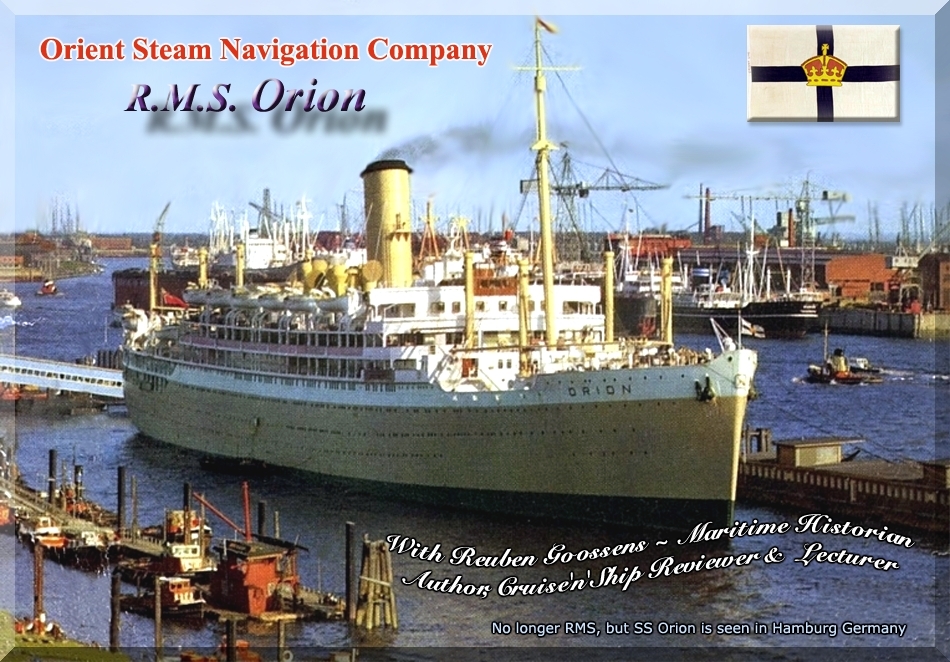
RMS
Orion (later the SS Orion) is still considered to be one of the most famous
ships on the Australian immigrant run, as she introduced a new standard in
ocean travel. Orion was the first British liner with air conditioning in all
her public rooms. Built by Vickers-Armstrong in Barrow, Furness, England,
she was launched on December 7, 1934 and completed in August 1935.
However her launching stands apart in British
maritime history, for was an event, which no British ship had ever
experienced. RMS Orion was launched by
remote control via wireless all the way from Brisbane
Australia.
The Duke of Gloucester, whilst he was Down
Under, officiated and pressed a button that transmitted a radio signal to
Barrow where the launching took place. The idea was actually copied from the
launching of a Holland-Africa liner when radio waves were used for the first
time. Due to this launch, she immediately has a special affiliation with Australia.
Specifications:
Tonnage: 23,371
GRT (gross registered tonnes)
Length: 665ft
(202.7m)
Beam: 82ft
(25.6m)
Draught: 30ft
(9.1m)
Engines: Six
Parsons SRG Steam Turbines (24,100 SHP)
Screws: Two
Service speed: 21
knots.
Passenger Decks: Seven
Passengers: 708 Cabin Class, 700 Tourist Class. Later 1,691 One Class
(Tourist)
Crew: 466,
later 565
When built, Orion was
the largest Orient liner and as can be seen above, she was originally built as
a two class ship. By 1961, she was converted to a One
Class liner. Orion was the first Orient liner to be painted in that much loved
Orient Line livery with a corn coloured hull. She paved the way for all Orient
/ P&O liners that succeeded her.
Her
interiors had an extensive use of chromium and bakelite,
which set her apart from all previous Orient liners. The reason for the use of
these surfaces was that these materials offered resistance to the effects of
the sea air. Her décor was certainly original for the time.
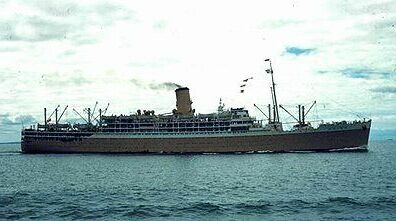
Orion
- full steam ahead at sea
Photograph
taken by & © Alan Judge (UK)
When
delivered to Orient Lines in August 1935, she undertook several short cruises
from London.
Then on September 28, she departed Tilbury for her maiden voyage to Australia.
Until the war broke out in 1939, Orion operated main line voyages to Australia with occasional cruises from the UK.
She
was acquired by the British government as a trooper seeing her sail to Egypt and Wellington,
New Zealand where she took
on troops for Europe. She left Wellington on January 6,
1940 and joined with other ships in convoy for Sydney Australia to rendezvous
with her sister ship Orcades. The convoy then left Australia
for Egypt.
The Orion departed Liverpool on August 15,
1941 as part of a convoy (WS10X) carrying Australian troops from the UK back to Singapore
sailing via Freetown,
where they arrived on August 28 and departed again on September 1. However, as
Orion was sailing directly astern of the HMS Revenge in the South
Atlantic apparently the steering gear onboard the HMS Revenge
malfunctioned and Orion being unable to come to a full stop quickly rammed the
Revenge. The impact caused considerable damage to Orion’s bow, but
although badly damaged she managed to continue to Cape Townwith this
convoy and upon arrival temporary repairs were mad. In October she departed and
joined a new convoy bound for Bombay (WS11X). Although Orion continued her
voyage to Singapore
where she remained for 55 days in dry-dock for her repairs to be completed. Some
believe that the Orion was bound for Egypt,
but this was never the case, she only joined the first convoy for safety sake
and was always due to sail as far as Cape Town
and then she joined another convoy sailing across the Indian Ocean and then
continued to Singapore.
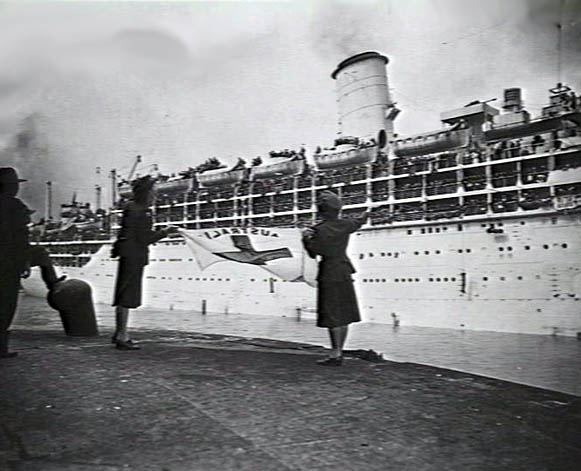
The Orion serving as a troop ship is seen arriving in Sydney, Australia obviously having some wounded onboard
It
was about this time the Japanese were closing in on Singapore
and thus Orion was again enlisted, but this time it was to evacuate civilians
to the safety of Australia.
She remained an essential troop carrier during the war years doing all that was
required of her. In October 1942 she was one of many acquired liners which
participated in “Operation Torch” and made two trips to North Africa carrying over 5,000 troops each time. In
1943 her troop carrying capacity was increased to 7,000 which, along with other
vessels such as USS West Point (SS America) played a huge role in the
positioning of the Western Allied Forces. Her role as a troop carrier tapered
off in the Pacific there after, but she continued moving troops some 5,000 per
voyage. When she was finally released from active duties, Orion had carried
over 175,000 soldiers and civilians and according to her log, she steamed over
380,000 miles.
Orion
was returned to the shipyard at Barrow on May 1, 1946, where she received a
complete refit, which took almost a year, but this included a redesign of all
passenger accommodation. At completion she could now carry 546 First Class and
706 in Tourist.
She finally departed from Tilbury on February 25, 1947 for Australia.
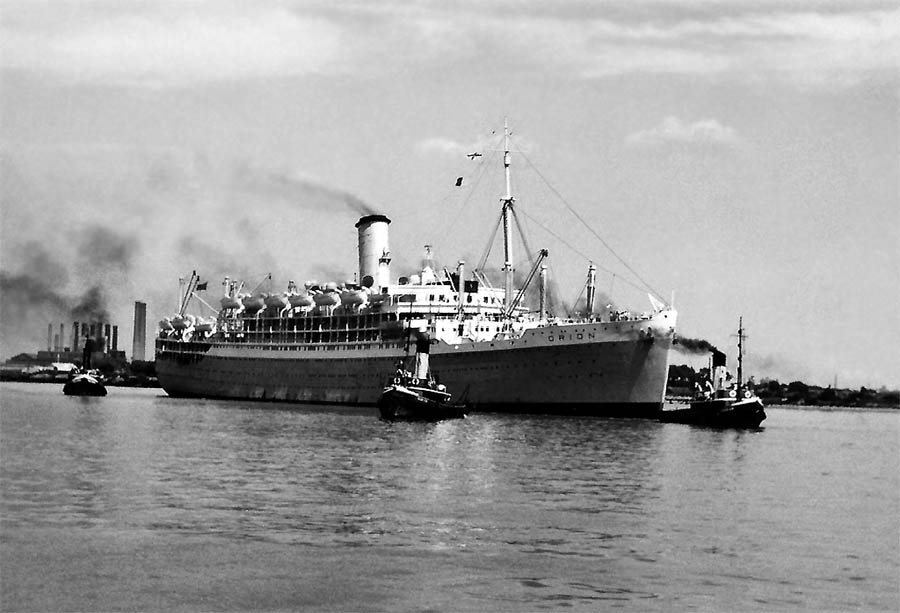
The Orion is seen on the Thames
whilst under tow on July 5, 1955
Photograph taken by
the late Mr. George Page who was a tug crewmember
Photograph was
provided & is © by great grandson Mr. Andrew
Pargeter
Beside her main line voyages to Australia and New
Zealand she also made three cruises to the West coast of America. Then
in 1958 she received further changes to her accommodations and when completed
she then accommodated 342 Cabin Class and 722 Tourist Class passengers.
However, in 1961 she was converted to become a One-Class Liner and then
accommodating a total of 1,691 passengers.
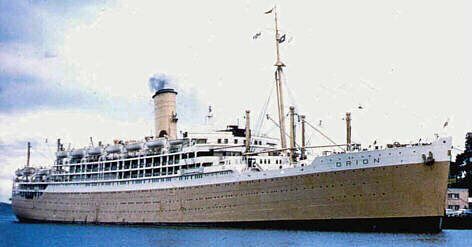
Orion
in port
Sadly
her days were rapidly coming to an end as new and superior ships had been built
and passenger’s numbers had declined on line voyages and thus P&O
decided to retire her in 1963.
For her final voyage to Australia, she departed Tilbury on February 28,
1963, sailing via the Suez for Sydney. With great
fanfare, she departed Sydney with great fanfare
on April 8 and set sail for Fremantle via Melbourne.
Flying an 85-foot paying-off pennant from her mast she departed Fremantle and Australia
on April 15. SS Orion arrived at Tilbury on May 15, 1963 with her future unsure.
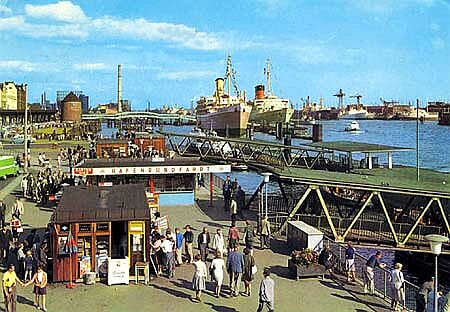
Seen
as a floating hotel in Hamburg
She
was chartered for four months as a floating hotel at the “International
Horticultural Exhibition in Hamburg,
where she arrived on May 23, 1963. She offered accommodation for 1150 guests.
At the conclusion of the exhibition on September 30, she darted the next day
she for Antwerp
where she was broken up by the Jos Boel et Fils scrap yard.
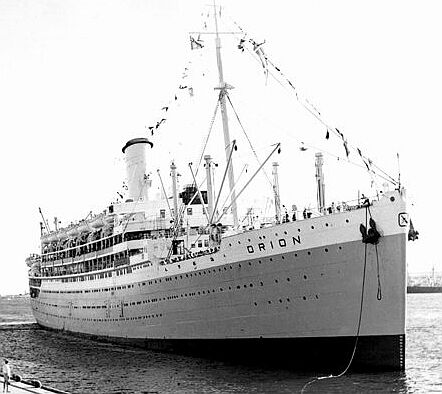
Orion looking festive as she is casting off during her popular cruises
RMS/SS Orion Index
RMS Orion … Orion - History Page.
Photo Album … Orion - Interior and exterior
photographs.
Passenger
Contribution - 1 … Ben Zuber heads for Australia in 1961.
Passenger Contribution -
2 … Jack Abbott - a Soldiers Tale - “Orion Oracle” No 20.
Passenger Contribution -
3 … Jack Abbott - a Soldiers Tale - “Orion Oracle” No 29.
Passenger
Contribution - 4 … William Rishton sails for Australia
in 1956.
Passenger Contribution -
5 … Anne Lee
UK
to Sydney Australia in 1958.
**********************************
Also Visit our Features on the following Orient Lines/P&O Ships
Orient Lines: RMS Orcades – SS Oronsay - SS Oriana - RMS Orion
P&O: RMS Strathaird - SS Himalaya - SS Iberia - RMS Kaisar-i-Hind - SS Canberra
***********************************
Return
to the ssMaritime MAIN INDEX
ssMaritime.com & ssMaritime.net
Where
the ships of the past make history & the 1914
built MV Doulos Story
Please
Note: ssmaritime and associated sites are 100% non-commercial
and the author seeks no funding or favours of any
shape or form, never have and never will!
Photographs
on ssmaritime and associate pages are by the author or
from the author’s private collection. In addition there are some images
that have been provided by Shipping Companies and private photographers or
collectors. Credit is given to all contributors. However, there are some
photographs provided to me without details regarding the photographer/owner
concerned. I hereby invite if owners of these images would be so kind to make
them-selves known to me (my email address may be found on www.ssmaritime.com only), in order that due credit may be
given.
This
notice covers all pages, although, and I have done my
best to ensure that all photographs are duly credited and that this notice is
displaced on each page, that is, when a page is updated!
ssMaritime is owned
& © Copyright by Reuben Goossens - All Rights Reserved







